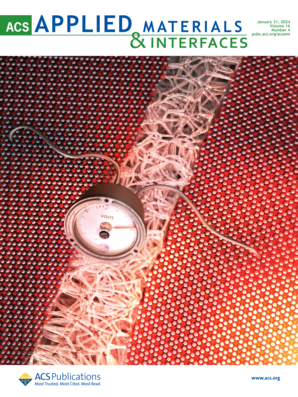One-Step Coordinating POPD in H3BTB-Sensitized EuMOF-Enabled Tunable Antenna Effects for Fluorescence Turn-On Sensing of Sarin Analogue Vapor
IF 8.3
2区 材料科学
Q1 MATERIALS SCIENCE, MULTIDISCIPLINARY
引用次数: 0
Abstract
The structural modification of metal–organic frameworks (MOFs) is of vital importance in many fields, especially in sensing with enhanced performance, while the efficient synthesis of functionalized MOF nanoparticles toward small molecule detection remains challenging. Here, a general cellulose nanofibril (CNF)-induced in situ one-step strategy was proposed for the synthesis of dual-ligand-functionalized europium-based MOF (EuMOF@CNF) nanoparticles under an effective regulation of the crystallization kinetics in hydrothermal synthesis. Based on the unique dual-ligand structure, the obtained EuMOF featured a tunable antenna effect and laid a good foundation for fluorescence-sensing materials. Benefiting from the superior self-assembly properties of CNFs and the tunable antenna effect of EuMOF@CNF, flexible sensing films were constructed, showing excellent mechanical properties (72 MPa for stress and 3.8% for strain) and tunable luminescence properties and achieving instant (1 s) and sensitive fluorescence sensing of sarin analogue vapor with a significantly low limit of detection (LOD, 2.8 ppb) and robust selectivity against a wide range of common interferents (>14 types), especially independent of common acids. We believe that this pioneering design of EuMOF with tunable antenna effects would positively advance the development of high-performance MOF-based fluorescent materials and devices.

一步协调POPD在h3btb敏化eumof使能的可调谐天线效应中用于沙林模拟蒸气的荧光开启传感
金属有机骨架(MOF)的结构修饰在许多领域都具有重要意义,特别是在增强传感性能方面,而高效合成功能化MOF纳米颗粒用于小分子检测仍然是一个挑战。本文提出了一种通用的纤维素纳米纤维(CNF)诱导的原位一步合成双配体功能化铕基MOF (EuMOF@CNF)纳米颗粒的策略,该策略有效地调节了水热合成中的结晶动力学。基于独特的双配体结构,所获得的euof具有可调谐的天线效应,为荧光传感材料奠定了良好的基础。利用CNFs优越的自组装性能和EuMOF@CNF的可调谐天线效应,构建了柔性传感膜,具有优异的力学性能(应力72 MPa,应变3.8%)和可调谐的发光性能,实现了沙林类似物蒸汽的即时(1 s)和敏感的荧光传感,具有显著的低检测限(LOD, 2.8 ppb)和对广泛的常见干扰(>;14类型)的强大选择性。特别独立于普通酸的。我们相信,这种具有可调谐天线效应的euof的开创性设计将积极推动高性能mof基荧光材料和器件的发展。
本文章由计算机程序翻译,如有差异,请以英文原文为准。
求助全文
约1分钟内获得全文
求助全文
来源期刊

ACS Applied Materials & Interfaces
工程技术-材料科学:综合
CiteScore
16.00
自引率
6.30%
发文量
4978
审稿时长
1.8 months
期刊介绍:
ACS Applied Materials & Interfaces is a leading interdisciplinary journal that brings together chemists, engineers, physicists, and biologists to explore the development and utilization of newly-discovered materials and interfacial processes for specific applications. Our journal has experienced remarkable growth since its establishment in 2009, both in terms of the number of articles published and the impact of the research showcased. We are proud to foster a truly global community, with the majority of published articles originating from outside the United States, reflecting the rapid growth of applied research worldwide.
 求助内容:
求助内容: 应助结果提醒方式:
应助结果提醒方式:


